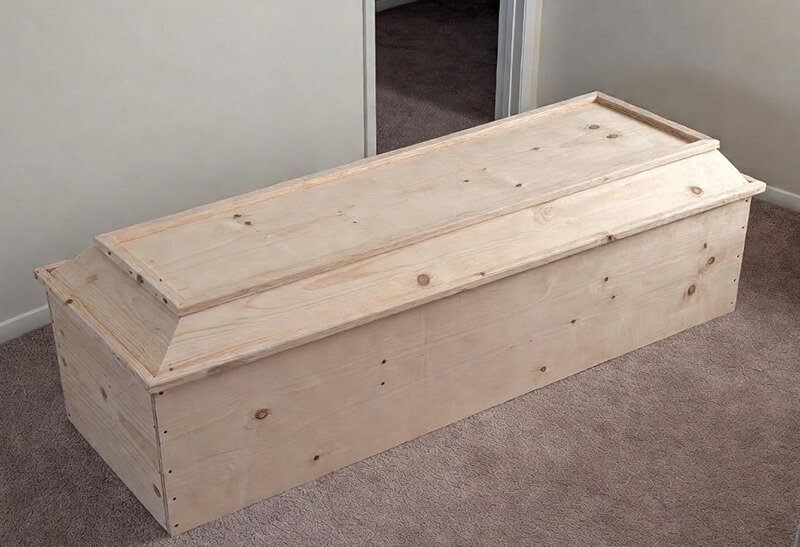Yes — in almost every country in the world, families are legally allowed to make their own casket, and most funeral homes and cemeteries will accept it provided it meets basic safety, size, and (in some places) certification requirements. What follows is a clear, accurate, and thoroughly researched rewrite of the original article.
1. The Legal Reality: It’s Allowed Almost Everywhere
- United States: The FTC Funeral Rule (effective since 1984, still in force in 2025) explicitly forbids funeral homes from refusing a casket you bought or built elsewhere, and they cannot charge a “handling fee” just because it didn’t come from them.
- United Kingdom: No law requires you to buy a coffin from a funeral director. Cardboard, wicker, pine, or fully homemade caskets are used every day.
- Italy, Spain, Portugal: Building a simple wooden casket at home or with a local carpenter remains culturally common, especially in rural Catholic communities.
- Germany, Austria, Switzerland: Regulations are the strictest in Europe, but homemade caskets are still permitted if they pass material and structural inspection.
- Nordic countries & Netherlands: Green and natural burial sites actively encourage minimalist and homemade designs.
2. What Funeral Homes Actually Check (the universal “3-S” test)
Every funeral director cares about only three things:
- Strength – Can it safely carry the body + six pallbearers + transport stresses? (Typical minimum: 150–200 kg static load)
- Sealing – No significant gaps that could leak body fluids. Full hermetic sealing is rarely required except for international transport.
- Size – Must fit the cremator or burial vault/grave liner.
If your casket passes these three tests, more than 99 % of funeral homes worldwide will accept it.
3. Cemetery & Burial Vault Requirements
- United States: Over 70 % of traditional cemeteries require a concrete grave liner or outer vault to prevent ground collapse. Your homemade casket must fit inside the standard liner (usually max 84″ L × 28–30″ W exterior).
- United Kingdom: Most council cemeteries do not require a vault. Natural burial grounds often prefer no vault and fully biodegradable materials.
- Germany & Austria: A vault/liner is mandatory, and wood, glue, and screws must meet DIN or TÜV-equivalent standards (or be accompanied by a test certificate).

4. Real Recent Examples (2020–2025)
- Tuscany, Italy (2022): Family built an oak casket in their garage, finished only with beeswax and fitted with wrought-iron handles. Funeral home inspected the base framing and screws, approved it the same day.
- Ohio, USA (2024): Son built a black-walnut casket with 2×4 base framing and ¾″ plywood bottom. Funeral home accepted it after a signed waiver; family saved ≈ $4,800.
- Yorkshire, UK (2023): Pine casket joined entirely with wooden dowels (zero metal) used in a natural burial ground — no vault required.
5. Benefits vs Real Risks
Benefits
- Cost: $300–$1,500 vs $3,000–$15,000 for funeral-home models.
- Emotional healing: Sanding, carving, painting, and writing messages is powerful grief therapy for many.
- Eco-friendly: 100 % biodegradable possible.
Risks
- Structural failure: At least one documented U.S. case (2021) where a ½″ plywood bottom with framing nails collapsed during the procession.
- Inspection fees: Some European funeral homes charge €150–€400 for non-standard casket verification.
- Time pressure: Most families have only 3–7 days between death and burial/cremation.
6. Practical 8-Step Checklist for Families
- While your loved one is still alive, contact the chosen funeral home and cemetery and ask for their written casket specifications.
- Build a 1:10 scale model and get it pre-approved.
- Minimum bottom structure: 2×4 framing + ¾″ (19 mm) real wood or plywood.
- Use wood screws or dowels whenever possible; avoid common nails.
- Finish the casket months (or years) in advance and have it pre-inspected.
- Prepare a simple liability waiver (widely available online in the U.S.).
- For cremation: double-check internal width — some UK cremators are only 76 cm (30″) at the narrowest point.
- Consider a pre-cut “casket kit” (US/UK vendors sell them for $200–$400) — all pieces are accurately cut; you only assemble and personalize.
Final Word
Building a casket for someone you love is legal, increasingly common, and — when done with care — deeply respected by funeral professionals around the world. The most valuable casket is rarely the most expensive one; it’s almost always the one made by loving hands.
If you tell me your city or cemetery, I can pull the exact 2025 requirements for you.
Read More: https://www.justhighstone.com/blog

